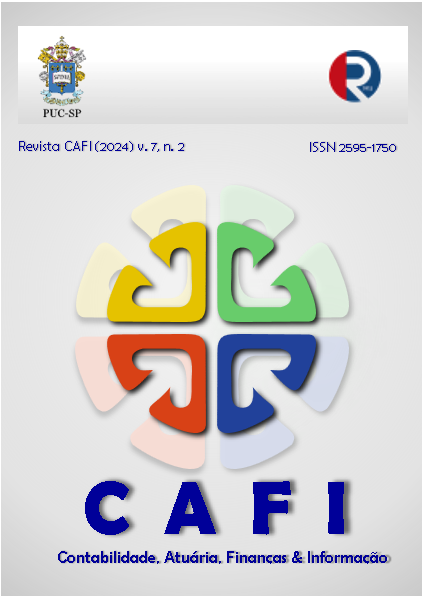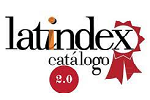Beyond profit:
a study on the distribution of wealth of the largest companies in Brazil Through DVA
DOI:
https://doi.org/10.23925/cafi.72.67896Keywords:
DVA, Companies, Social Function, Distribuition of wealthAbstract
The study aimed to analyze the social function of companies and the distribution of wealth generated by the largest companies in Brazil in 2023. It investigated how the largest companies in Brazil distribute the wealth generated, identifying which companies are the largest generators of wealth, the sectors to which they belong and the main beneficiaries of the wealth generated. To select the 20 largest companies, the Ranking of the Largest Companies published by Exame Magazine (2024) was used, with the Statement of Added Value being the main source of accounting information. The methodology adopted was exploratory and bibliographic. The sample covered a total of R$1.009 trillion in distributed wealth, equivalent to 10% of GDP (R$10.9 trillion), referring to 17 (seventeen) companies. The results indicated that, of the total wealth generated by the 17 largest companies in the country, 34% was allocated to the Government through taxes, 30% was allocated to shareholders through dividends, interest on equity or profit retention, 24% was allocated to employees and 12% was allocated to financial institutions and rentals. This article offers a valuable contribution to academic literature, business, government and society by presenting a detailed and quantitative analysis of the distribution of wealth generated by Brazil's largest companies in 2023. This has important implications for economic equity, policymaking, and understanding the social role of companies.
References
Assaf Neto, A. (2012). Estrutura e análise de balanço.Atlas.
Beck, S., Bertholle, L., & Child, J. (1961). Mastering the art of French cooking. Knopf.
Brasil. Presidência da República. Casa Civil. Subchefia para Assuntos Jurídicos. (1976, 15 de dezembro). Lei Nº 6.404, de 15 de dezembro de 1976. Dispõe sobre as Sociedades por Ações. Brasília. http://www.planalto.gov.br/ccivil_03/leis/l6404consol.htm
Brasil. Presidência da República. Casa Civil. Subchefia para Assuntos Jurídicos. (1988, 5 de outubro). Constituição da República Federativa do Brasil de 1988. Brasília. Disponível em https://planalto.gov.br/ccivil_03/constituicao/constituicao.htm .
Child, J. (1974). Journal, 1974. [Unpublished journal]. Papers of Julia Child, 1925-1993(MC 644, item 4). Schlesinger Library on the History of Women in America, Radcliffe Institute, https://id.lib.harvard.edu/ead/c/sch00222c00006/catalog .
Coelho, F. U. (2020). Princípios constitucionais na Interpretação das normas de direito comercial. In L. F. Salomão, R. V. B. Cueva, & A. Frazão (Coords.), Lei de liberdade econômica e seus impactos no direito brasileiro. Thomson Reuters Brasil.
Comitê de Pronunciamentos Contábeis. (2008). Pronunciamento técnico CPC 09 (R1): Demonstração do Valor Adicionado. https://s3.sa-east-1.amazonaws.com/static.cpc.aatb.com.br/Documentos/632_CPC%2009%20R1.pdf .
Comparato, F. K. (1990). Direito Empresarial: estudos e pareceres.Saraiva.
Comparato, F. K. (1996). Estado, Empresa e Função Social. Revista dos Tribunais, 732, 41.
De Paula, R. Z. A. (2020). Capitalismo – Definições. São Luíz: EDUFMA. https://www.edufma.ufma.br/wp-content/uploads/woocommerce_uploads/2020/06/PAULA-Ricardo-Zimbrao-Affonso-de-Capitalismo-Defini%C3%A7oes-Livro-1.pdf .
Empresômetro. (2024). Estatísticas. Market Map Price. Você conhece as estatísticas de empresas ativas no Brasil? https://empresometro.com.br/Estatisticas.
Evraert, S., & Riahi‐Belkaoui, A. (1998). Usefulness of value added reporting: a review and synthesis of the literature. Managerial Finance, 24(11), 1-15. https://doi.org/10.1108/03074359810765679 .
Frazão, A. (2011). Função Social da Empresa. Renovar.
Freeman, R. E. (1984). Strategic management: A stakeholder approach. Pitman.
Friedman, M. (1970, 13 de setembro). The Social Responsibility of Business Is to Increase Its Profits. New York Times Magazine. http://umich.edu/~thecore/doc/Friedman.pdf . 2024.
Garcia, P. H. R. (2015). A função social da empresa e o desenvolvimento nacional. Cadernos Jurídicos, 16(39), 91-117. https://www.tjsp.jus.br/download/EPM/Publicacoes/CadernosJuridicos/37de%2006.pdf?d=636688261614679211 . Acesso em 8 de junho de 2024.
Gil, A. C. (2010). Como elaborar projetos de pesquisa. Atlas.
Instituto de Pesquisa Aplicada - IPEA – IBGE. (2024). PIB cresce 2,9% em 2023 e fecha o ano em R$ 10,9 trilhões. Publicado em 01/03/24. https://agenciadenoticias.ibge.gov.br/agencia-sala-de-imprensa/2013-agencia-de-noticias/releases/39303-pib-cresce-2-9-em-2023-e-fecha-o-ano-em-r-10-9-trilhoes .
Iudícibus, S. (1997). Teoria da contabilidade.Atlas.
Luca, M. M. M. (1998). Demonstração do valor adicionado: do cálculo da riqueza criada pela empresa ao valor do PIB. Atlas.
Malacrida, Jane M.C., DOS SANTOS, Ariosvaldo. (2022). Demonstração do valor adicionado: como foi distribuída a riqueza gerada pelos ramos de atividade entre 1999 e 2018?. Revista De Educação E Pesquisa Em Contabilidade (REPeC), 16(3). https://www.repec.org.br/repec/article/view/3159 .
Melhores e Maiores 2023. (2024). Revista Exame. Abril. https://exame.com/mm/maiores/
Ministério da Fazenda. (2024). Estimativa da Carga Tributária Bruta do Governo Geral 2023. https://www.tesourotransparente.gov.br/publicacoes/carga-tributaria-do-governo-geral/2022/114#:~:text=Em%202023%2C%20a%20carga%20tribut%C3%A1ria,PIB%20em%20rela%C3%A7%C3%A3o%20a%202022 .
Muneal, M. (2011). Studies in Popular Culture, 34(1), 152–154. www.jstor.org/stable/23416357.
Pêgas, P. H. (2011). Manual de Contabilidade Tributária (7ª ed.). Freitas Bastos.
Piccolli, Márcio R., Duarte, Andréia M., Leder, Scheila S. (2018).Geração e Distribuição das Riquezas das Empresas Brasileiras: Uma Análise da Demonstração Do Valor Adicionado. Periodicos UNOESC. https://periodicos.unoesc.edu.br/apeuj/article/download/17367/9042.
Pires, Maria Aparecida E.S. Demonstração do Valor Adicionado: Um Estudo sobre a Distribuição da Riqueza Gerada pelas Empresas Listadas na Bm&Fbovespa entre 2015 e 2016. https://www.unirv.edu.br/conteudos/fckfiles/files/DEMONSTRA%C3%87%C3%83O%20DO%20VALOR%20ADICIONADO%20UM%20ESTUDO%20SOBRE%20A%20DISTRIBUI%C3%87%C3%83O%20DA%20RIQUEZA%20GERADA%20PELAS%20EMPRESAS%20LISTADAS%20NA%20BM&FBOVESPA%20ENTRE%202015%20E%202016.pdf .
Pompeu, G. V. M., & Santiago, A. M. (2019). Função Social da Empresa: Análise Doutrinária e Jurisprudencial Face às Decisões do STJ. Revista Brasileira de Direito Empresarial. https://www.indexlaw.org/index.php/direitoempresarial/article/download/5799/pdf.
Prodanov, C. C., & Freitas, E. C. (2013). Metodologia do trabalho científico: Métodos e técnicas da pesquisa e do trabalho acadêmico. Feevale.
Schwab, Klaus. (2021).Stakeholder Capitalism: A Global Economy that Works for Progress, People and the Planet: Alta Cult.
Downloads
Published
How to Cite
Issue
Section
License
Copyright (c) 2024 CAFI

This work is licensed under a Creative Commons Attribution 4.0 International License.
Declaração de Direito Autoral
Autores mantém os direitos autorais e concedem à revista o direito de primeira publicação, com o trabalho simultaneamente licenciado sob a Licença Creative Commons Attribution que permite o compartilhamento do trabalho com reconhecimento da autoria e publicação inicial nesta revista.
Declaração de Privacidade
Os nomes e endereços informados nesta revista serão usados exclusivamente para os serviços prestados por esta publicação, não sendo disponibilizados para outras finalidades ou a terceiros.









